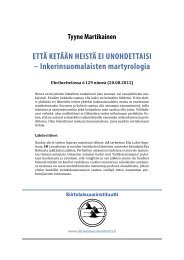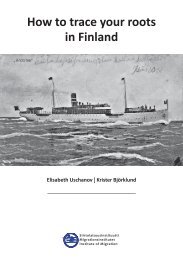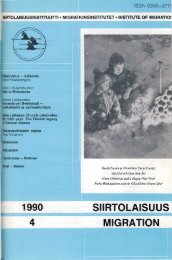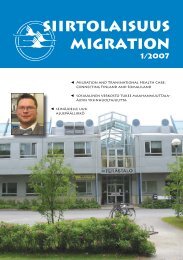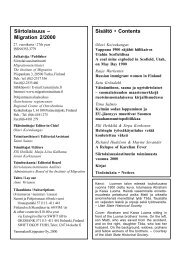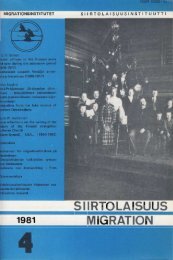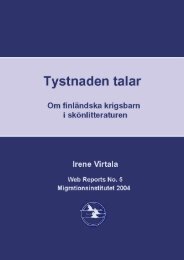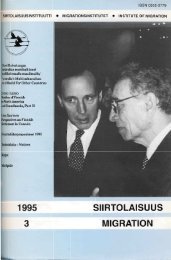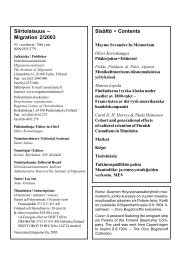1992 - 2 - Siirtolaisuusinstituutti
1992 - 2 - Siirtolaisuusinstituutti
1992 - 2 - Siirtolaisuusinstituutti
You also want an ePaper? Increase the reach of your titles
YUMPU automatically turns print PDFs into web optimized ePapers that Google loves.
Finnish-Amsrican ldontity<br />
The personal qualities described in the experiences that our children would<br />
the preceding paragraphs, I know, are identify as part of their "Finnishness".<br />
not true of every Finn or every American Our son Eric, aged 9, spent a short vaca-<br />
but they do form an ideal that guides tion with my husband's relatives. On a<br />
one's behavior.<br />
walk through the woods, he and an<br />
I grew up and married a man whose older cousins found half of an old,<br />
parents were immigrants from Finland. weathered top of a wooden grain barrel.<br />
Our backgrounds were much the same. Carved deeply into the top was a "puu-<br />
My grandmother didn't ask (as she often merkki" E.T. The date was 1841. After<br />
did when she would hear of an impend- some lengthy and interesting family hising<br />
marriag e) " Onko se toiskielinen? " The tory (and much coffee) we learned that<br />
Finnish families where I grew up usu- there had been another Erkki Typpo<br />
ally knew each other very well. There is over a century ago. The old banel had<br />
more diversity now and communities lain deep in the woods for all those years<br />
that were predominantly Finnish years until this little boy from America, with<br />
ago have had to accomodate to this the same name, found it.<br />
change. It does make a difference in Identification, or the act of creating an<br />
one's "rootedness" or the exterrt to identity, involves two processes. The<br />
which other people know you and your first, as our son learned, is finding the<br />
family, etc. Family customs and rituals ways in which we are similar to family<br />
can be remarkably resistant to change, or culture. We may look to history or folk<br />
especially if they are valued and en- heroes or heroines. The complementary<br />
couraged.<br />
process is defining those beliefs, quali-<br />
We made our first trip to Finland as ties or characteristics on which we are<br />
exchange students in1957. Many things different. For Firurish-American child-<br />
about Finland were already familiar to ren and adults, it is easy to see all the<br />
us, since they had been part of our own ways in which we are similar to family<br />
backgrounds. We contacted relatives we or culture. In truth. there is much simi-<br />
had been told about and were welcomed larity between the American and Fin-<br />
by them as FAMILY. We have been back nish "Ideal Adult". The differences may<br />
many times now and lived in Turku lie in the ways and the extent our two<br />
during a Fulbright year. We, in turn, cultures charLnel the expression of the<br />
wanted our two children to identify with same qualities.<br />
their Finnish "roots". This meant that The United States does not have a<br />
they went io a public school, learned the<br />
language, sang the songs and played the<br />
games. I became very aware that, to<br />
some extent, we were "orchestrating"<br />
similar saying but the ending of Paavo's<br />
'O[e<br />
letter stays in mind: aina i[oinen,<br />
niinfoin pbni p erfi onen ".<br />
26




